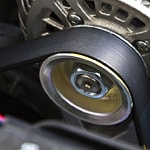
 A timing belt plays a very important role in the operation of the vehicle's engine system. It helps make sure that the camshaft and crankshaft in the engine work together at the right speed. The camshaft operates valves that let air and gas into the engine. The crankshaft moves pistons up and down, which power the engine and ultimately your vehicle. A timing belt ensures that both the valves and pistons in your engine are timed correctly to ensure proper engine performance.
A timing belt plays a very important role in the operation of the vehicle's engine system. It helps make sure that the camshaft and crankshaft in the engine work together at the right speed. The camshaft operates valves that let air and gas into the engine. The crankshaft moves pistons up and down, which power the engine and ultimately your vehicle. A timing belt ensures that both the valves and pistons in your engine are timed correctly to ensure proper engine performance.
We at MINI of Burlington in Shelburne, VT want to educate our customers about timing belts and want to stress the importance of periodic timing belt replacements. Timing belts naturally wear out over time and should be replaced every 100,000 miles or so for newer vehicles, or depending on the manufacturer's specifications. Older vehicles may need to have timing belts replaced sooner.
Signs that a belt may have to be replaced soon include worn-out teeth on the belt, cracks on the back, and damaged edges. Trouble starting the vehicle and high pitch sounds could be additional signs that a belt is worn out and needs to be replaced. A timing belt failure can lead to engine failure, so it is absolutely important that worn timing belts be replaced promptly.